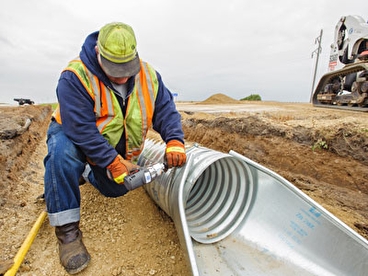Reliable Underbrush Clearing for Clean and Safe Land
Reliable Underbrush Clearing for Clean and Safe Land
Blog Article
Attain Success With Culvert Setup: Best Practices Revealed
Setting up culverts is a critical facet of infrastructure development, calling for accuracy and adherence to finest methods for long-term success. Whether carrying out a brand-new job or keeping existing culverts, the process needs precise interest to detail. From the first product choice to the final stages of maintenance, each action plays a vital duty in the performance and long life of the culvert system. In this discussion, we will certainly explore crucial methods, pointers, and standards that can significantly influence the outcome of culvert setups. Recognizing these crucial elements is critical in making certain the structural stability and performance of culverts, making it important for experts and fanatics alike to understand these foundational concepts.
Correct Product Selection

Plastic culverts are light-weight, corrosion-resistant, and economical, making them a preferred selection for different culvert installations. Inevitably, choosing the appropriate product is crucial to make sure the culvert system works efficiently and has a lengthy service life (Road construction).
Site Preparation Tips
Efficient website preparation is essential for the effective installation of culverts, guaranteeing appropriate integration with the surrounding setting and lasting capability. Before beginning the installation process, it is crucial to conduct a complete site analysis to figure out the ideal size, kind, and positioning of the culvert. Cleaning the location of any type of debris, vegetation, or obstructions is the primary step in website prep work. This makes certain a clean and level surface area for the culvert to be installed.
Next, the dirt conditions must be evaluated to examine the security and load-bearing capacity of the ground. Relying on the soil type, extra measures such as compaction or reinforcement might be essential to stop clearing up or changing of the culvert with time. Proper water drainage factors to consider need to likewise be taken into consideration to stop water build-up around the culvert, which can bring about erosion or structural damage.
Finally, developing proper access to the site for building and construction tools and making certain compliance with any type of regulative demands are important elements of site prep Related Site work. By complying with these site preparation tips, the installation of culverts can be executed efficiently and properly, advertising the longevity and performance of the culvert system.
Setup Methods

To start with, it is important to precisely determine and mark the location where the culvert will certainly be mounted. The trench ought to be dug to the correct deepness and size, try this out taking into account the size and kind of culvert being installed.
Following, the culvert must be put in the trench complying with the supplier's standards. Appropriate positioning is critical for the performance and durability of the culvert. Backfilling the trench with the appropriate product and compacting it in layers is the final action in the setup procedure. This guarantees the culvert is safely in location and prepared to hold up against the demands it will deal with. By complying with these installment strategies vigilantly, the culvert will be successfully installed, adding to the general success of the project.
Upkeep Standards
After completing the mindful setup of culverts following correct techniques, adherence to upkeep standards is paramount to guarantee their durability and performance. Routine inspection is critical to recognize any type of signs of wear, obstructions, or architectural damage early. Inspections must include examining for sediment accumulation, disintegration around the culvert sides, and any indications of corrosion or corrosion. Cleaning debris, such as branches or leaves, from the inlet and electrical outlet on a regular basis is necessary to stop clogs that can cause flooding.
Additionally, maintaining correct incline and positioning of the culvert is essential for reliable water circulation and to protect against possible blocking. Road construction. Any plant life near the culvert need to be handled to avoid root invasion and obstructions. In areas vulnerable to freezing temperatures, implementing winter season maintenance techniques such as making certain appropriate drainage to stop ice build-up is important
Routine maintenance not just prolongs the lifespan of culverts yet likewise ensures they work successfully in handling water flow, reducing the danger of damages to facilities and bordering locations.
Troubleshooting Common Issues
Attending to typical issues that might emerge with culverts calls for a methodical approach and mindful evaluation of the underlying reasons. One frequent problem run into is clogs within the culvert, typically brought on by debris accumulation or sediment build-up. To troubleshoot this concern, normal evaluations and upkeep are vital to guarantee correct performance. Additionally, incorrect setup bring about imbalance or insufficient slope can result in water flow disturbances or even structural damage. By checking the culvert pop over to this site alignment and slope consistently, potential concerns can be recognized and remedied without delay.

Conclusion
Finally, achieving success with culvert installation calls for careful factor to consider of material option, complete site preparation, appropriate installation techniques, and regular maintenance. By complying with best methods and fixing usual concerns, the stability and performance of culverts can be made sure. It is vital to stick to guidelines and referrals to avoid any kind of possible issues and guarantee the longevity of the culvert system.
Report this page